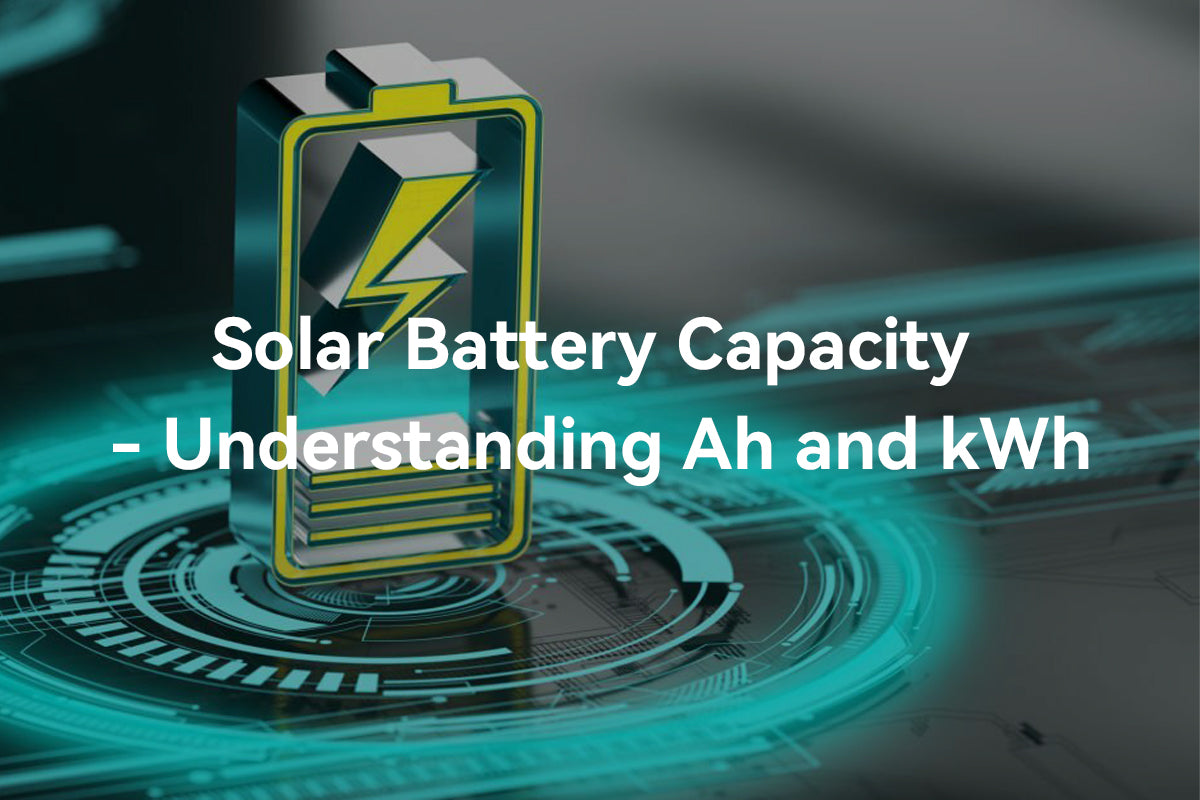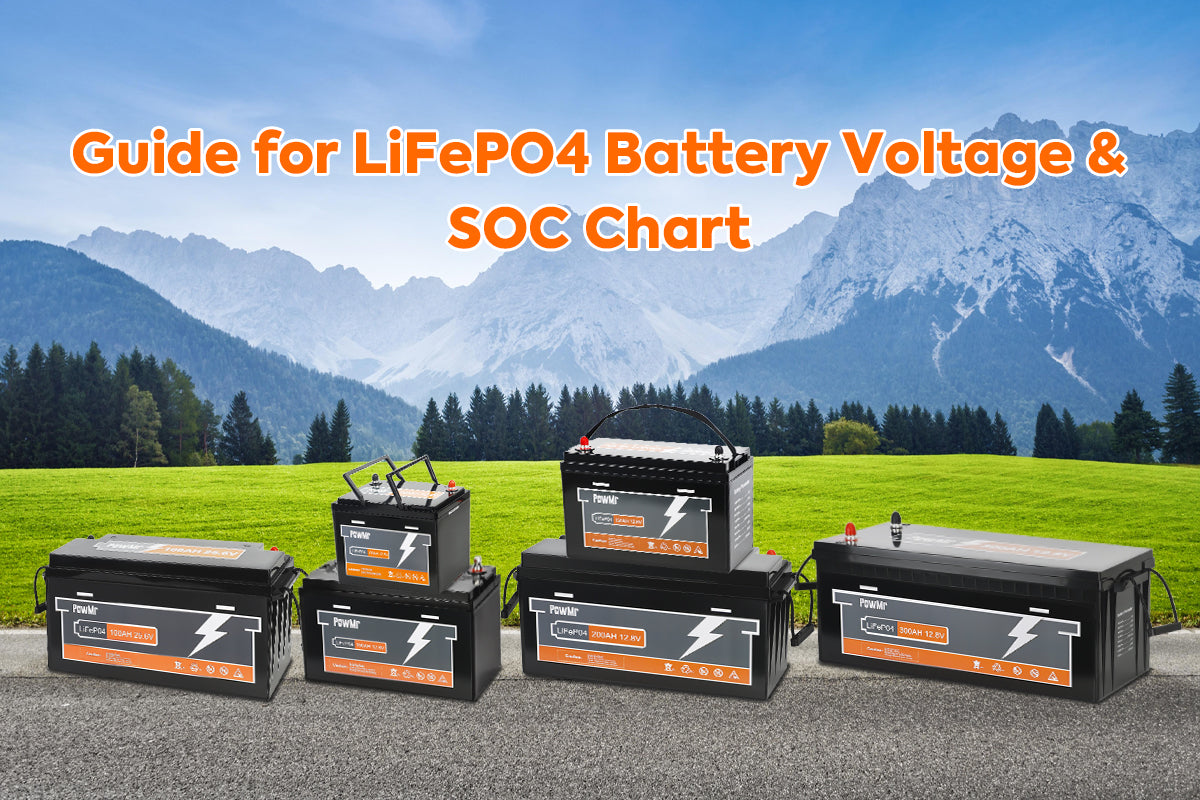แบตเตอรี่ลิเธียมเหล็กฟอสเฟต (LiFePO4) ได้รับความนิยมเนื่องจากมีความหนาแน่นพลังงานสูงและอายุการใช้งานยาวนาน เพื่อให้แน่ใจในความปลอดภัยและประสิทธิภาพที่ดีที่สุดของแบตเตอรี่ LiFePO4 การปฏิบัติตามวิธีการชาร์จและแนวทางที่เหมาะสมจึงเป็นสิ่งสำคัญ
บทความนี้ตรวจสอบ วิธีการชาร์จ อัลกอริธึม แรงดันไฟฟ้าที่แนะนำสำหรับการชาร์จ แบตเตอรี่ ระบบต่างๆ ในระยะการชาร์จที่แตกต่างกัน และ เคล็ดลับความปลอดภัย สำหรับการชาร์จแบตเตอรี่ LiFePO4.
วิธีการชาร์จ LiFePO4
ในส่วนนี้ เราจะสำรวจวิธีการชาร์จ LiFePO4 ที่เหมาะสม ไม่ว่าจะเป็นวิธีการชาร์จที่เลือก—พลังงานแสงอาทิตย์, พลังงาน AC, หรือ DC-DC—สิ่งสำคัญคือต้องยืนยันความเข้ากันได้ระหว่างที่ชาร์จที่เลือกและแบตเตอรี่ LiFePO4 เพื่อให้มั่นใจในประสิทธิภาพที่ดีที่สุด อายุการใช้งานที่ยาวนาน และความปลอดภัยในระหว่างกระบวนการชาร์จ.
ชาร์จด้วยพลังงานแสงอาทิตย์
การใช้พลังงานแสงอาทิตย์ในการชาร์จแบตเตอรี่ LiFePO4 เป็นวิธีการที่ ยั่งยืนและเป็นมิตรกับสิ่งแวดล้อม การใช้ ตัวควบคุมการชาร์จพลังงานแสงอาทิตย์ วิธีนี้จัดการพลังงานที่ผลิตโดยแผงโซลาร์เซลล์ได้อย่างมีประสิทธิภาพ ควบคุมกระบวนการชาร์จและรับประกันการถ่ายโอนพลังงานที่เหมาะสมไปยังแบตเตอรี่ LiFePO4 การใช้งานนี้เหมาะสำหรับ การตั้งค่าแบบไม่เชื่อมต่อกับกริด, สถานที่ห่างไกล, และ โซลูชันพลังงานที่ใส่ใจต่อสิ่งแวดล้อม.
โพสต์ที่เกี่ยวข้อง:
คู่มือการเลือกตัวควบคุมการชาร์จพลังงานแสงอาทิตย์ - ประเภทและขนาด
ชาร์จด้วยแหล่งจ่ายไฟฟ้า AC
การชาร์จแบตเตอรี่ LiFePO4 ด้วยแหล่งจ่ายไฟ AC ให้ ความหลากหลายและความเชื่อถือได้ เพื่อเพิ่มประสิทธิภาพในการชาร์จแบตเตอรี่ LiFePO4 ด้วยแหล่งจ่ายไฟ AC แนะนำให้ใช้ อินเวอร์เตอร์ไฮบริด ประเภทนี้นอกจากจะรวมตัวควบคุมการชาร์จพลังงานแสงอาทิตย์แล้ว ยังมี เครื่องชาร์จ AC ที่สามารถ ชาร์จแบตเตอรี่จากทั้งเครื่องกำเนิดไฟฟ้า และกริดไฟฟ้า วิธีนี้เหมาะสำหรับทั้งระบบพลังงานที่เชื่อมต่อกับกริดและระบบพลังงานสำรอง โดยมีความยืดหยุ่นในตัวเลือกการชาร์จ.
อัลกอริธึมการชาร์จ LiFePO4
แบตเตอรี่ LiFePO4 ใช้เทคนิค การชาร์จแบบ CCCV ซึ่งประกอบด้วยสองขั้นตอน: การชาร์จกระแสคงที่ (การชาร์จแบบเบิกบาน) และการชาร์จแรงดันคงที่ (การชาร์จแบบดูดซับ) ซึ่งคล้ายกับสองขั้นตอนแรกของการชาร์จแบตเตอรี่ตะกั่ว-กรด โดยมีความแตกต่างเพียงในพารามิเตอร์แรงดัน.

ในขั้นตอน การชาร์จแบบกระแสคงที่ (Bulk) เครื่องชาร์จแบตเตอรี่ LiFePO4 จะส่งกระแสเฉพาะไปยังแบตเตอรี่ในขณะที่ค่อยๆ เพิ่มแรงดันไฟฟ้าเพื่อให้ถึงแรงดันไฟฟ้าสูงสุด กระแสชาร์จและแรงดันไฟฟ้าสูงสุดจะถูกตั้งค่าจากผู้ใช้.
ใน ขั้นตอนการชาร์จด้วยแรงดันไฟฟ้าคงที่ (การดูดซับ) ตัวชาร์จจะค่อยๆ ลดกระแสไฟฟ้าลงในขณะที่รักษาแรงดันไฟฟ้าที่ตั้งเป้าไว้ โดยพื้นฐานแล้ว ทั้งขั้นตอน Bulk และ Absorption มีเป้าหมายเพื่อให้ถึงและรักษาแรงดันไฟฟ้าที่ตั้งเป้าเดียวกัน.
เมื่อเปรียบเทียบกับแบตเตอรี่ตะกั่ว-กรด ซึ่งมี สามขั้นตอนการชาร์จ และต้องการการชาร์จเต็มทุกวันเพื่อป้องกันการเกิดซัลเฟตของวัสดุที่ใช้งาน แบตเตอรี่ลิเธียมเหล็กฟอสเฟต เนื่องจากมีอัตราการคายประจุที่ต่ำกว่า ไม่ต้องการ การชาร์จแบบหยดหรือต่อเนื่อง.
ชาร์จลอย LiFePO4 หรือไม่?

อย่างไรก็ตาม ในสถานการณ์การใช้งานจริง มีคำถามที่ถูกยกขึ้นบ่อยครั้ง: ควรใช้การชาร์จลอยสำหรับ LiFePO4 หรือไม่? คำตอบคือไม่ ความสับสนนี้มักเกิดจากความจริงที่ว่าหลาย ตัวควบคุมการชาร์จ มีตัวเลือกหลายอย่างตามเคมีของแบตเตอรี่ เช่น แบตเตอรี่ตะกั่ว-กรด ซึ่งต้องการการชาร์จลอย ดังนั้นจึงไม่แปลกใจที่ตัวควบคุมการชาร์จจะมีพารามิเตอร์ที่ปรับได้ซึ่งเกี่ยวข้องกับกระบวนการชาร์จนี้.
หากคุณไม่สามารถปิดการใช้งานขั้นตอน 'float charge' ได้ คุณควร ตั้งค่าแรงดันไฟฟ้า float ให้ต่ำลง การปรับนี้ช่วยป้องกันไม่ให้ สถานะการชาร์จของแบตเตอรี่ (SOC) สูงเกินไป ซึ่งอาจลดอายุการใช้งานของแบตเตอรี่ได้.
แผนภูมิแรงดันชาร์จ LiFePO4
การเข้าใจวิธีการชาร์จของแบตเตอรี่ LiFePO4 เปิดเผยว่าค่าความดันไฟฟ้าสำหรับการชาร์จแบบ bulk และ absorption นั้นเหมือนกัน นอกจากนี้ เพื่อให้แน่ใจในความปลอดภัยและอายุการใช้งานของแบตเตอรี่ แบตเตอรี่ LiFePO4 มีพารามิเตอร์ แรงดันไฟฟ้าสำคัญ ได้แก่ การตัดแรงดันไฟฟ้าต่ำ (แรงดันไฟฟ้าที่แบตเตอรี่หยุดการจ่ายไฟ) และ การตัดแรงดันไฟฟ้าสูง (แรงดันไฟฟ้าที่แบตเตอรี่หยุดการชาร์จ)
พารามิเตอร์เหล่านี้มักจะมีรายละเอียดในแผ่นข้อมูลของแบตเตอรี่ คุณยังสามารถตรวจสอบและควบคุมระดับการชาร์จและการปล่อยของแบตเตอรี่โดยอ้างอิงจาก แผนภูมิแรงดัน SOC ของ LiFePO4 ภายในช่วงที่อนุญาต.
ตัวอย่างเช่น สำหรับ PowMr แบตเตอรี่ LiFePO4 ขนาด 12V 100Ah ควรกำหนดแรงดันไฟฟ้าชาร์จอยู่ระหว่าง 10.8V ถึง 14.6V โดยจุดตัดแรงดันไฟฟ้าต่ำควรสูงกว่า 10.8V และจุดตัดแรงดันไฟฟ้าสูงควรต่ำกว่า 14.6V เช่นเดียวกับ แบตเตอรี่ขนาด 24V ควรกำหนดแรงดันไฟฟ้าชาร์จอยู่ระหว่าง 21.6V ถึง 29.2V โดยจุดตัดแรงดันไฟฟ้าต่ำอยู่ที่ 21.6V และจุดตัดแรงดันไฟฟ้าสูงอยู่ที่ 29.2V.
นอกจากนี้ สิ่งสำคัญคือต้องไม่เกิน กระแสชาร์จสูงสุด ที่ผู้ผลิตกำหนด เนื่องจากอาจส่งผลต่อประสิทธิภาพและความปลอดภัยของแบตเตอรี่
พารามิเตอร์การชาร์จสำหรับแบตเตอรี่ LiFePO4 อาจแตกต่างกันไปขึ้นอยู่กับผู้ผลิต ตารางด้านล่างแสดงพารามิเตอร์การชาร์จสำหรับแบตเตอรี่ 3.2V, 12V, 24V และ 48V.
| พารามิเตอร์ | ระบบ 12V | ระบบ 24V | ระบบ 48V |
| แรงดันไฟฟ้าจำนวนมาก | 14V – 14.6V | 28V – 29.2V | 56V – 58.4V |
| แรงดันไฟฟ้าดูดซับ | 14V – 14.6V | 28V – 29.2V | 56V – 58.4V |
| เวลาการดูดซึม | 0- 6 min | 0- 6 min | 0- 6 min |
| แรงดันลอยตัว | 13.8 โวลต์ ± 0.2 โวลต์ | 27.6 โวลต์ ± 0.2 โวลต์ | 55.2 โวลต์ ± 0.2 โวลต์ |
| การตัดแรงดันไฟต่ำ | 10V | 20V | 40V |
| การตัดแรงดันไฟฟ้าสูง | 14.6 | 29.2โวลต์ | 58.4โวลต์ |
เคล็ดลับในการชาร์จ LiFePO4 อย่างปลอดภัย
เคล็ดลับในการชาร์จ LiFePO4 แบบขนาน
- ตรวจสอบให้แน่ใจว่าแบตเตอรี่เป็น แบรนด์เดียวกัน, ประเภท แบตเตอรี่เดียวกัน และมีขนาดเดียวกัน.
- ขณะเชื่อมต่อแบตเตอรี่ LiFePO4 แบบขนาน กรุณาให้แน่ใจว่าแบตเตอรี่แต่ละก้อนมีแรงดันไฟฟ้าอยู่ภายใน 0.1V ของกันและกันก่อนที่จะนำไปใช้งาน ซึ่งจะช่วยลดโอกาสในการเกิดความไม่สะดวกระหว่างแบตเตอรี่.
- ความต้านทานภายในน้อยกว่า 0.05 Ω ความแตกต่างระหว่างเซลล์/แบตเตอรี่ใด ๆ สองเซลล์ ตรวจสอบให้แน่ใจว่าสายเคเบิลและตัวเชื่อมต่อทั้งหมดมีความยาวและขนาดเท่ากันเพื่อให้แน่ใจว่าการเชื่อมต่อภายในมีความต้านทานเท่ากัน.
- เมื่อชาร์จแบตเตอรี่แบบขนาน กระแสชาร์จที่ได้จากพลังงานแสงอาทิตย์ จะถูกแบ่งครึ่ง ในขณะที่ความจุการชาร์จสูงสุดจะเพิ่มขึ้นเป็นสองเท่า ตัวอย่างเช่น พิจารณาแบตเตอรี่ 48V 100Ah สองก้อนที่เชื่อมต่อแบบขนาน โดยแต่ละก้อนมีค่ากระแสชาร์จสูงสุดที่ 50A ในการตั้งค่านี้ แบตเตอรี่รวมสามารถชาร์จด้วยกระแสรวมสูงสุดถึง 100A ซึ่งแปลเป็นอัตราการชาร์จที่มีประสิทธิภาพที่ 50A สำหรับแต่ละแบตเตอรี่ โดยสมมติว่ามีสถานะการชาร์จ (SOC) เท่ากัน
เคล็ดลับในการชาร์จ LiFePO4 แบบอนุกรม
- ก่อนการชาร์จแบบอนุกรม ให้แน่ใจว่าประเภท ยี่ห้อ และความจุของแบตเตอรี่แต่ละก้อนเหมือนกัน มิฉะนั้นจะทำให้เกิดความไม่สมดุลของแรงดันไฟฟ้าระหว่างแบตเตอรี่ ส่งผลให้เกิดการชาร์จเกินหรือลดน้อยลง ซึ่งจะส่งผลต่อประสิทธิภาพและอายุการใช้งานของแบตเตอรี่.
- ขณะเชื่อมต่อแบตเตอรี่แบบอนุกรม กรุณาให้แน่ใจว่าแบตเตอรี่แต่ละก้อนอยู่ภายใน 50mV (0.05V) ของกันและกันก่อนที่จะนำไปใช้งาน สิ่งนี้จะช่วยลดโอกาสในการเกิดความไม่สะดวกระหว่างแบตเตอรี่ หากแบตเตอรี่ของคุณเกิดการไม่สมดุล แรงดันไฟฟ้าของแบตเตอรี่ใด ๆ จะต้องมีค่า >50mV (0.05V) จากแบตเตอรี่ก้อนอื่นในชุด คุณจะต้องชาร์จแบตเตอรี่แต่ละก้อนแยกกันเพื่อปรับสมดุลใหม่.
เคล็ดลับ:
คุณสามารถชาร์จแบตเตอรี่แต่ละก้อนแยกกันเป็นระยะเพื่อหลีกเลี่ยงความไม่สม่ำเสมอ ขณะชาร์จแบตเตอรี่ LiFePO4 แบบอนุกรม ควรใช้เครื่องชาร์จหลายตัว/เครื่องแปลงสัญญาณไฮบริด MPPT หลายตัว ที่ชาร์จแบตเตอรี่แต่ละก้อนโดยเฉพาะเพื่อรับประกันว่าเซลล์จะยังคงปรับสมดุล คุณยังสามารถใช้เครื่องชาร์จแบตเตอรี่ LiFePO4 ขนาด 24V หรือเครื่องชาร์จแบตเตอรี่ LiFePO4 ขนาด 48V หากคุณต้องการชาร์จระบบของคุณโดยรวม.
การชาร์จแบตเตอรี่โดยตรงด้วยแผงโซลาร์เซลล์ได้หรือไม่
ไม่แนะนำให้ชาร์จแบตเตอรี่โดยตรงด้วยแผงโซลาร์เซลล์ เนื่องจากแรงดันไฟฟ้าและกระแสไฟฟ้าของแผงโซลาร์เซลล์จะแปรผันตามความเข้มและมุมของแสงแดด ซึ่งอาจเกินขอบเขตการชาร์จของแบตเตอรี่ LiFePO4 ส่งผลให้เกิดการชาร์จเกินหรือชาร์จไม่พอ ส่งผลกระทบต่อประสิทธิภาพและอายุการใช้งานของแบตเตอรี่.
ดังนั้น เพื่อใช้แผงโซลาร์เซลล์ในการชาร์จแบตเตอรี่ LiFePO4 อย่างปลอดภัย คุณจำเป็นต้องเพิ่มตัวควบคุมการชาร์จระหว่างแผงโซลาร์เซลล์และแบตเตอรี่
คำถามที่พบบ่อยเกี่ยวกับการชาร์จ LiFePO4
คำถามที่พบบ่อยเกี่ยวกับการชาร์จ LiFePO4
ด้วยการปล่อยประจุที่น้อยมาก แม้จะมีช่วงเวลาที่ไม่ใช้งานนานถึงหกเดือนก็จะไม่ทำให้ประจุลดลงมากนัก ดังนั้น ควรชาร์จแบตเตอรี่ LFP ก่อนที่จะลดลงถึงจุดชาร์จ 20% (80% ความลึกของการปล่อยประจุ) เพื่อให้แน่ใจว่าระบบจัดการแบตเตอรี่ (BMS) ทำงานได้อย่างถูกต้อง.
ต้องใช้แอมป์เท่าไหร่ในการชาร์จแบตเตอรี่ LiFePO4
กระแสชาร์จสำหรับแบตเตอรี่ LiFePO4 (ลิเธียมเหล็กฟอสเฟต) ขึ้นอยู่กับความจุและข้อกำหนดของผู้ผลิต โดยทั่วไปแนะนำให้ชาร์จแบตเตอรี่ LiFePO4 ด้วยกระแสที่อยู่ระหว่าง 0.5C ถึง 1C โดยที่ C คือความจุของแบตเตอรี่ในแอมป์-ชั่วโมง.
ตามที่ได้กล่าวไว้ข้างต้น ในสถานการณ์การชาร์จแบบขนาน ความจุการชาร์จสูงสุดจะรวมกัน และกระแสการชาร์จที่ได้จากพลังงานแสงอาทิตย์จะถูกกระจายอย่างเท่าเทียมกัน ส่งผลให้ลดอัตราการชาร์จสำหรับแบตเตอรี่แต่ละก้อน ดังนั้นจึงเป็นสิ่งสำคัญที่จะต้องทำการปรับเปลี่ยนตามจำนวนแบตเตอรี่ที่เกี่ยวข้องและความต้องการเฉพาะสำหรับแต่ละแบตเตอรี่.
ฉันสามารถชาร์จ LiFePO4 ด้วยเครื่องชาร์จแบตเตอรี่ตะกั่วได้ไหม
"ไม่ว่าจะสามารถใช้เครื่องชาร์จแบตเตอรี่ที่มีการกัดกร่อนของตะกั่วเพื่อชาร์จ LiFePO4 ได้หรือไม่ คำตอบสั้น ๆ คือ ใช่ โดยมีความยาวเท่ากับแรงดันไฟฟ้าที่ตั้งอยู่ภายในขอบเขตที่เหมาะสมสำหรับแบตเตอรี่ลิเธียมเหล็กฟอสเฟต"
การชาร์จแบตเตอรี่ LiFePO4 ใช้เวลานานแค่ไหน
แบตเตอรี่ LiFePO4 มักรองรับอัตราการชาร์จที่เร็วขึ้น และเวลาชาร์จอาจอยู่ในช่วงไม่กี่ชั่วโมงถึงหลายชั่วโมง ขึ้นอยู่กับเงื่อนไขเฉพาะ เช่น ความจุของแบตเตอรี่ อัตราการชาร์จ และวิธีการชาร์จที่ใช้.



